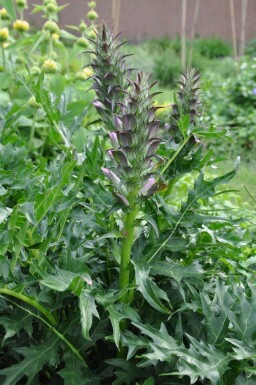Description
Acanthus spinosus | Spiny bear's breech
The Acanthus spinosus, commonly known as spiny bear's breech, is a striking perennial that adds architectural elegance to any garden. With its origins in the Mediterranean, this robust plant is admired for its glossy green foliage and magnificent flower spikes that emerge in the warmer months.
Key Features
The Acanthus, or armed bear's breech, is renowned for its upright, bushy growth habit, which can reach up to 1 meter in height. Its dark green, deeply cut leaves are crowned with towering spires of purple and white flowers, creating a dramatic display from July to September.
Key attributes of Acanthus spinosus include:
- Flowers that add a striking visual appeal to borders and group plantings, or as a solitary specimen.
- Adaptability to various soil types, provided they are well-drained.
- An ability to thrive in both sun and partial shade, making it versatile in garden design.
- Drought resistance, which ensures survival in drier conditions once established.
- Deciduous foliage that maintains a green color from spring through summer.
Tips
For gardeners looking to introduce Acanthus spinosus into their landscapes, consider the following tips:
- To propagate, division is recommended during spring or autumn to promote vigorous growth and maintain plant health.
- Root cuttings can also be a successful method, ideally taken in late autumn or early winter. These should be placed in cutting compost and allowed to establish over a year before transplanting.
- Regular watering is necessary, particularly during the establishment phase and in periods of extended dryness, to satisfy its average water requirements.
- When situating your Acanthus spinosus, ensure it has enough space to accommodate its mature size, both in height and spread.































